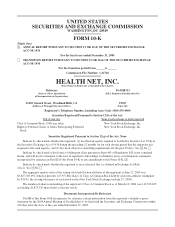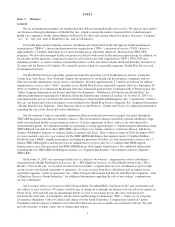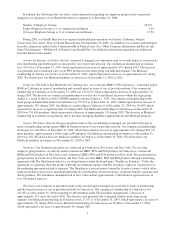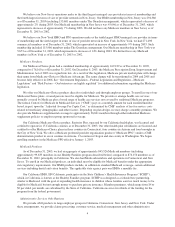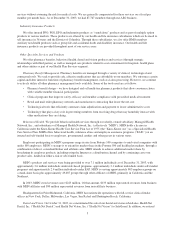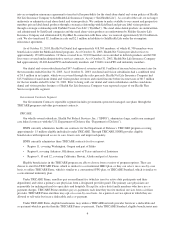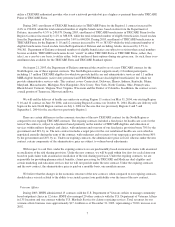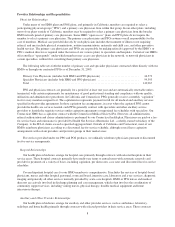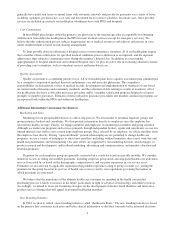Health Net 2003 Annual Report Download - page 11
Download and view the complete annual report
Please find page 11 of the 2003 Health Net annual report below. You can navigate through the pages in the report by either clicking on the pages listed below, or by using the keyword search tool below to find specific information within the annual report.generally have multi-year terms or annual terms with automatic renewals and provide for payments on a variety of bases,
including capitation, per diem rates, case rates and discounted fee-for-service schedules. In certain cases, these provider
services are included in contracts our health plan subsidiaries have with PPGs and hospitals.
Cost Containment
In most HMO plan designs, either the primary care physician or the treating specialist is responsible for obtaining
authorization from either the health plan or the PPG for most medical services (except for emergency services). We
believe that this authorization process reduces inappropriate use of medical resources and achieves efficiencies in cases
where reimbursement is based on risk-sharing arrangements.
To limit possible abuse in utilization of hospital services in non-emergency situations, all of our health plans require
that a member obtain certification for specified medical conditions prior to admission as an inpatient, and the inpatient
admission is then subject to continuing review during the member’s hospital stay. In addition to reviewing the
appropriateness of hospital admissions and continued hospital stays, we play an active role in evaluating alternative means
of providing care to members, such as outpatient services and home-based care.
Quality Assessment
Quality assessment is a continuing priority for us. All of our health plans have a quality assessment plan administered
by a committee composed of medical directors and primary care and specialist physicians. The committees’
responsibilities include periodic review of medical records, development and implementation of standards of care based
on current medical literature and community standards, and the collection of data relating to results of treatment. All of
our health plans also have a subscriber grievance procedure and/or a member satisfaction program designed to respond
promptly to member grievances. Elements of these subscriber grievance procedures and member satisfaction programs are
incorporated both within the PPGs and within our health plans.
Additional Information Concerning Our Business
Marketing and Sales
Marketing for our group health business is a three-step process. We first market to potential employer groups and
group insurance brokers and consultants. We then provide information directly to employees once the employer has
selected our health coverage. Finally, we engage members and employers in marketing for member and group retention.
Although we market our programs and services primarily through independent brokers, agents and consultants, we use our
limited internal sales staff to serve certain large employer groups. Once selected by an employer, we solicit enrollees from
the employee base directly. During “open enrollment” periods when employees are permitted to change health care
programs, we use a variety of techniques to attract new enrollees, including, without limitation, direct mail, work day and
health fair presentations and telemarketing. Our sales efforts are supported by our marketing division, which engages in
product research and development, multicultural marketing, advertising and communications, and member education and
retention programs.
Premiums for each employer group are generally contracted on a yearly basis and are payable monthly. We consider
numerous factors in setting our monthly premiums, including employer group needs and anticipated health care utilization
rates as forecasted by us based on the demographic composition of, and our prior experience in, our service areas.
Premiums are also affected by applicable regulations that prohibit experience rating of group accounts (i.e., setting the
premium for the group based on its past use of health care services) and by state regulations governing the manner in
which premiums are structured.
We believe that the importance of the ultimate health care consumer (or member) in the health care product
purchasing process is likely to increase in the future, particularly in light of advances in technology and online resources.
Accordingly, we intend to focus our marketing strategies on the development of distinct brand identities and innovative
product service offerings that will appeal to potential health plan members.
New Branding Initiative
In 2004, we plan to rollout a new branding initiative called “the Rosetta Stone.” The new branding initiative is based
on the premise that consumers need more and better clinical information so that they can make better informed decisions
9

